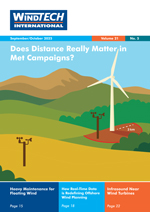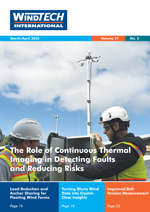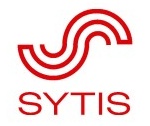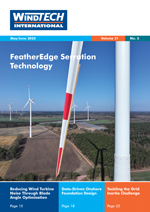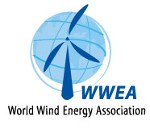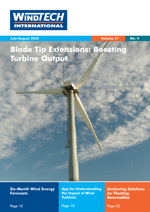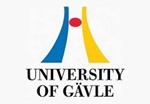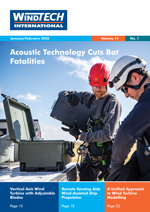- Category: 2025
The Front CoverPuget Sound Energy transitioned from conventional diagnostic methods to an advanced, fixed, bispectral infrared camera solution, fundamentally transforming its approach to wind turbine maintenance. The article on page 6 explores how the adoption of this technology resulted in improvements in technician safety, operational efficiency, real-time diagnostics, and proactive failure prevention, ultimately reshaping best practices for wind energy infrastructure maintenance. Publisher's NoteGlobal wind energy markets: Chinese dominance and expanded EU industrial policyFeaturesThe Role of Continuous Thermal Imaging in Detecting Faults and Reducing Risks
By Troy Goss, Project Manager, Sytis, USA By Kasper Sandal, Engineering Specialist, Semar, Norway
By Mike Optis, Veer Renewables, and Jacob Schnell, University of Waterloo, Canada By Joshua Scott, Director of Research and Innovation, Predictant, USA
Windtech FutureUnworthy Wind Energy IdeasBy Ahmad Hemami, McGill University, Montreal, Canada View from InsideBy Arindam Das, Partner, Arthur D. Little, Benedikt Unger, Principal, Arthur D. Little Latest News
|
|
|||||||||||||||||||||||||
- Category: 2025
The Front CoverBiome Renewables has developed the FeatherEdge serration, a flexible hardware technology inspired by the silent flight of the owl. It is applied to the trailing edge of the outer third of the rotor blade, each section being roughly 500mm wide. The echnology has been tested on a variety of turbine sizes and in the article on page 6 you can read more about this solution. The mage on the cover shows the FeatherEdge Installed on Enercon E160 EP5 E3 in Hamilhausen, Germany. Publisher's NoteAnother bust and boom cycle ahead in the USA?FeaturesFeatherEdge Serration Technology
By Ryan Church, CEO, Biome Renewables, Canada By Martin Peters, Head of Measurement Department, Green Wind Engineering, Germany
By Chris van der Ploeg, Digital Innovation Lead, Windbase, the Netherlands By Kristina Carlquist, Head of Synchronous Condenser Product Line, ABB Large Motors and Generators, Sweden
Windtech FutureIntercontinental Transportation of Electric EnergyBy Ahmad Hemami, McGill University, Montreal, Canada View from InsideBy Stefan Gsänger, Secretary General, World Wind Energy Association, Germany Latest News
|
|
||||||||||||||||||||||||||||
- Category: 2025
The Front CoverBlade tip extensions offer a compelling alternative, increasing the rotor swept area to capture more wind and boost annual energy production by 5% to 15%. The article on page 6 explores the technical basis, realworld applications, and economic benefits of blade tip extensions, highlighting their role in enhancing wind farm efficiency. Publisher's NotePolicy divergence deepens between USA and Europe in wind energy developmentFeaturesBlade Tip Extensions: Boosting Turbine Output
By Jack Wallace, Principal / Business Development Manager, Renewable Performance Engineering, USA By Yazmina Zurita Martel, R&D Data Scientist, Nebbo Weather, Spain
By Erik Koppen, Principal Wind Energy and Noise Consultant, Arcadis, the Netherlands By Zachary Miller, Chief Technology Officer and Co-founder, Triton Anchor, USA
Windtech FutureCan yaw system be eliminated in floating wind turbines?By Ahmad Hemami, McGill University, Montreal, Canada View from InsideBy Jonathan Bruegel, Power Sector Analyst – Europe, Institute for Energy Economics and Financial Analysis Latest News
|
|
||||||||||||||||
- Category: 2025
The Front CoverIn wind resource assessment, the conventional approach to meteorological (met) mast siting has emphasised distance, recommending maintaining a maximum separation distance between each met site and the proposed wind turbine locations. This industry-accepted method assumes that shorter distances translate to better representativeness. But is distance truly the metric that matters most? The article on page 6 challenges this long-held belief. Publisher's NoteDaily legislative hurdles for renewable energy in the USAFeaturesDoes Distance Really Matter in Met Campaigns?
By Liz Walls and Erin Roekle, One Power Company, USA By Manu Centeno-Telleria, Researcher and Lecturer, Mondragon University, Spain
By Richard Chen, Customer Success Manager, Miros, Norway By Per Ängskog, Kourosh Tatar and José Chilo, University of Gävle, Sweden
Windtech FutureWind Turbines on BuildingsBy Ahmad Hemami, McGill University, Montreal, Canada View from InsideBy Endri Lico, Principal Analyst, Global Wind Supply Chain and Technology, Wood Mackenzie, Denmark Latest News
|
|
||||||||||||||||||||||||||
- Category: 2025
The Front CoverThe wind industry has long recognised its responsibility to minimise harm to bats and has implemented mitigation strategies to reduce fatalities. NRG’s Bat Deterrent System’s Bat Deterrent Unit emits ultrasound in the same range as bats’ natural calling frequencies. By reducing bat activity near turbines, this technology minimises the need for curtailment, allowing wind plants to maintain higher energy output while supporting bat conservation efforts. You can read more about the system at page 6. (Cover image courtesy of NRG Systems) Publisher's NoteUS energy policy shifts under new executive ordersFeaturesAcoustic Technology Cuts Bat Fatalities by 91%
By Brittany Good, Senior Marketing Specialist, NRG Systems, USA By Professor Friedrich Björn Grimm, Founder, RES Institute, Germany
By Floriane Grussenmeyer, Sales Manager for Maritime, Weather and Environment, Vaisala, France By Kirby Heck, Jaime Liew and Michael Howland, Massachusetts Institute of Technology, USA
Windtech FutureNot Practical for Floating WindBy Ahmad Hemami, McGill University, Montreal, Canada View from InsideBy Peter Lloyd-Williams, Senior Analyst – Offshore Wind, Westwood Global Energy Group, UK Latest News
|
|
||||||||||||||||||



